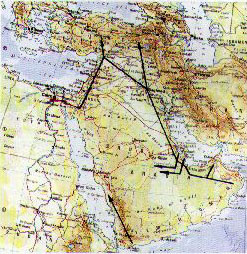|
Arab-Mashreq countries imply those Arab countries
which are in the east. The border
line between the east and the west
is not well defined geographically.
In a recent feasibility study for
the interconnection of the power
systems of the Arab-Masgreq countries,
the Arab countries which are east
of the Mediterranean Sea and the
Red Sea were grouped in four groups
while Egypt was considered, in the
said study as a group by itself
but, however, a part of the Arab-Mashreq
interconnection.
Starting from the east, we may consider
the power systems of the countries
within the Arab Peninsula as to
develop in one interconnected system.
It would include, mainly, the countries
along the gulf, namely from north
to south, Kuwait, Bahrain, Qatar,
United Arab Emirates, and Oman and
this group would eventually include
Yemen.
The largest electric utility in
this group is that of the Kingdom
of Saudi Arabia. It includes four
large electric utilities and several
smaller utilities. Only two of the
large utilities are at present interconnected
by 380 kV transmission lines, while
the others operate independently.
Plans are being studied and when
implemented the electric utilities
in Saudi Arabia will operate as
one interconnected system except
for some isolated small systems.
At present, about 4800 km of 380
kV transmission lines and a total
installed capacity of about 20000
MW are in operation. It is to be
pointed out that the operating frequency
is 60 Hz while the operating frequency
of other systems is 50 Hz and hence
integrating Saudi Arabia within
the Arab interconnection should
be through a back-to-back d.c. system.
This would be at Dhahran in Saudi
Arabia.
The interconnection system would
mainly be a 380 kV transmission
line along the Gulf from Kuwait
to Oman and tapped off to interconnect
with Bahrain, Saudi Arabia, Qatar
and the United Arab Emirates power
systems.

The said feasibility study recommended
that a transmission line would be
extended northwards to Iraq to interconnect
with the power systems of the countries
of the northern group, including
Iraq, Syria, Lebanon and Jordan.
This would be then interconnected
to the power system of Egypt. The
highest system voltage at present
is 380 kV in both Iraq and Jordan.
However, strengthening of the networks
within the countries would be necessary.
Accordingly, for this interconnection
system, a 400 kV/500 kV transformation
would be required to interconnect
Egypt, and a 60 Hz / 50 Hz d.c.
link transformation is required
to interconnect Saudi Arabia. The
first is a synchronous link, while
the second would be an asynchronous
link. The interconnection study
was based on the principle that
each member country is to remain
completely autonomous and solely
responsible for electricity services
within it's own boundaries. The
interconnection is to facilitate
energy back-up in emergency situations
for any member country without adverse
effect on the other countries
The target dates for this Arab Mashreq
interconnection were considered
in the study as:
- Egypt - Jordan 1997.
- Northern (central) Group 1998.
- Gulf countries group after year
2000
|
